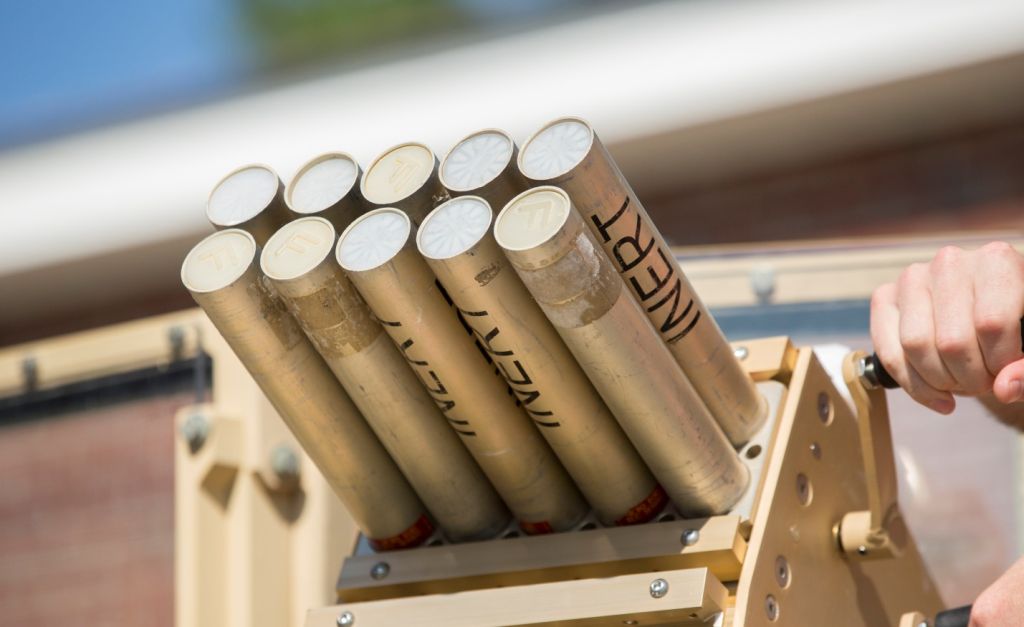For Marines running roadblocks and vehicle check points, identifying an oncoming vehicle as a threat is a decision that has to happen quickly and at standoff range because lives are on the line. A new system being fielded to II and III Marine Expeditionary Forces, Reserve Units and Marine Corps Forces Central Command will give Marines more certainty when distinguishing friend or foe.
The Non-Lethal/Tube Launched Munition System is a vehicle-mounted 40mm grenade launcher, which has a digital fire control and can shoot between one and 30 non-lethal rounds, depending upon the need. The rounds, which contain four flash-bang submunitions and fire from three banks of 10 launchers set for distances up to 100 meters, are visible out to 600 meters. The ammunition is an “all-up round,” meaning there is no assembly or disassembly required.
“Marines require something to be able to hail and warn from a distance” said Anita Tate, non-lethal team lead for NL/TLMS for Marine Corps Systems Command’s Infantry Weapons Systems. “What we have is a very safe, very easy-to-use system that will allow Marines guarding military checkpoints to better determine the intent of an approaching vehicle.”
Tate and the rest of the non-lethal team from MCSC are responsible for the acquisition and sustainment of the NL/TLMS.
The system is made to be mounted onto the turrets of Marine vehicles — Mine Resistant Ambush Protected vehicles and Humvees — or on ground tripods. On vehicle turrets, the NL/TLMS is mounted just to the left of the turret’s main weapon to allow for quick change between systems.
Every second matters, according to Tate. “These decisions are so quick,” she said. “In the past, that’s where uncertainty has made a difference: You have to protect yourself and your fellow Marines, but you don’t want to open fire on an unarmed vehicle. There’s a lot of pressure. This system allows you to make that decision quickly and with a clear conscience.”
Relieving that pressure is part of why non-lethal systems are so important to the military, according to Kelley Hughes, spokesperson for the Department of Defense Non-Lethal Weapons Program.
“Non-lethal weapons are designed and employed to achieve military objectives while minimizing human casualties or damage to property and equipment,” Hughes said. “Non-lethal weapons can also help clarify intent of an adversary,” she added.
During a train-the-trainer event aboard Marine Corps Base Camp Lejeune in Jacksonville, North Carolina, Marines had the opportunity to learn about the NL/TLMS.
After a morning in the classroom, Marines got to fire flash-bang rounds from the system. “I was pretty excited, we haven’t had much hands-on with it,” said 1st Lt. Adam Flannery. “It made a lot of noise and some pretty big bangs.”
As a part of the 2nd Law Enforcement Battalion, Flannery might make different use of the NL/TLMS. “It will be pretty useful in crowd dispersal or riot control,” he said. “It definitely expands our non-lethal capability.”
Also from 2nd LEB, 1st Lt. Josh Schubert appreciated how intuitive it was to operate the system. “It’s very user friendly,” he said. “It’s electric and has a remote control that looks like a video game controller — black plastic with red and yellow buttons on it. Pretty much every Marine who took the short course was able to step right up and use it without much problem.”
Flannery and Schubert were both interested in the possibility of other non-lethal munitions but were happy about the capability Marines were gaining. “It extends the range of our non-lethal systems,” Schubert said. “We can get a lot of non-lethal munitions downrange in the event of a disturbance.”
Fielding of the NL/TLMS to Marine units in the continental United States should be completed in early winter.










